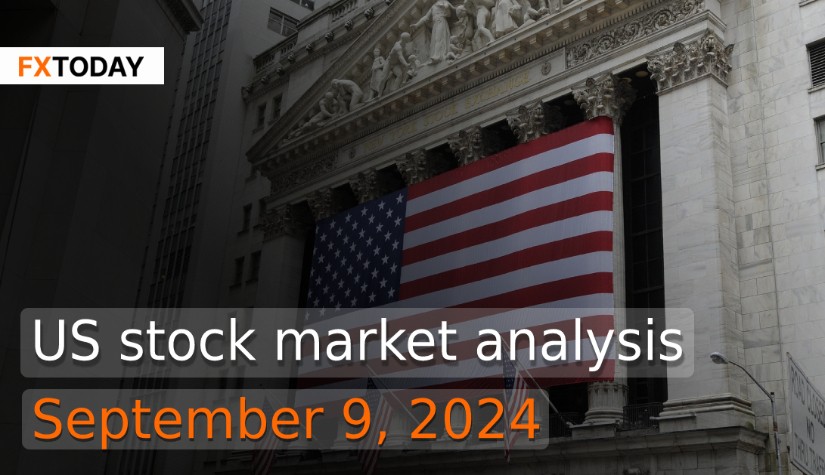Market Volatility Surges Amid Economic Uncertainty, Fed Policy Shifts, and Tight U.S. Election
The U.S. economy's uncertain outlook is causing market volatility, with investors facing changes in Federal Reserve policy, an upcoming tight U.S. election, and concerns over high valuations. U.S. stocks fell sharply after jobs data suggested a weaker labor market, making it harder for the Fed to achieve a "soft landing" — lowering inflation without harming growth. The Fed is expected to cut rates in September, but concerns are growing that high borrowing costs are already straining the economy.
Investors fear the Fed may not act swiftly enough to prevent further economic downturn. Market volatility increased, with the S&P 500 dropping 1.7% on Friday and posting its worst weekly loss since March 2023. Tech stocks, including Nvidia, suffered significant declines. Valuations remain high, with the S&P 500 trading at above-average price-to-earnings ratios, raising concerns about sustainability.
The tight U.S. presidential race adds to market uncertainty. September has historically been a tough month for stocks, and the recent market moves have reinforced this trend. Some analysts see signs of a cooling labor market that could precede a recession, with upcoming inflation data likely to influence future Fed decisions.
Despite short-term challenges, analysts at Bank of America maintain a positive outlook on Nvidia, citing strong growth prospects in AI and favorable valuations. Nvidia's position in AI, particularly with the upcoming generation of large language models, remains robust.
Wells Fargo added Microsoft and Adobe to its portfolio, highlighting Microsoft's AI-driven growth in cloud services and Adobe's strong position in generative AI. Goldman Sachs dismissed concerns of an AI bubble, emphasizing that tech sector fundamentals remain solid despite high valuations and market concentration.
Mizuho analysts included Micron Technology and Oracle in their top picks, anticipating growth driven by AI demand and competitive advantages in cloud services. However, JPMorgan downgraded Super Micro Computer due to regulatory uncertainties and competitive pressures, advising investors to wait until the company resolves compliance issues.
In a volatile market marked by tech stock fluctuations and unpredictable bond yields, U.S. infrastructure stands out for its stability and strong performance. This sector's appeal goes beyond short-term trends, driven by solid fundamentals and supportive government policies, including President Biden's 2021 infrastructure law, which ensures funding through 2026. Infrastructure investments enjoy bipartisan support, making them a reliable option regardless of election outcomes.
Since mid-July 2024, the stock market has been turbulent, especially for tech stocks, which are down 6.5% from their July highs. In contrast, U.S. infrastructure stocks have reached new highs, offering a defensive refuge for investors wary of recession risks. These stocks, largely in the communication services and utility sectors, are less sensitive to economic downturns and benefit from stable cash flows. Lower interest rates in a recession could also boost their returns.
However, risks remain, such as potential oil price spikes due to geopolitical tensions, which could negatively impact infrastructure stocks by driving up U.S. yields. Despite these risks, analysts suggest that market reactions to geopolitical events are often short-lived, making any dips in infrastructure stocks potential buying opportunities.
Data for Technical Analysis (1H) CFD US 500 [S&P 500]
Resistance : 5423.5, 5425.3, 5428.4
Support : 5417.3, 5415.5, 5412.4
1H Outlook
Source: TradingView
Buy/Long 1 If the support at the price range 5409.3 - 5417.3 is touched, but the support at 5417.3 cannot be broken, the TP may be set around 5424.9 and the SL around 5405.3, or up to the risk appetite.
Buy/Long 2 If the resistance can be broken at the price range of 5423.5 - 5431.5, TP may be set around 5440.0 and SL around 5413.3, or up to the risk appetite.
Sell/Short 1 If the resistance at the price range 5423.5 - 5431.5 is touched, but the resistance at 5423.5 cannot be broken, the TP may be set around 5416.9 and the SL around 5435.5, or up to the risk appetite.
Sell/Short 2 If the support can be broken at the price range of 5409.3 - 5417.3, TP may be set around 5400.0 and SL around 5427.5, or up to the risk appetite.
Pivot Points Sep 9, 2024 02:33AM GMT
|
Name
|
S3
|
S2
|
S1
|
Pivot Points
|
R1
|
R2
|
R3
|
|---|---|---|---|---|---|---|---|
| Classic | 5408.9 | 5412.4 | 5416.9 | 5420.4 | 5424.9 | 5428.4 | 5432.9 |
| Fibonacci | 5412.4 | 5415.5 | 5417.3 | 5420.4 | 5423.5 | 5425.3 | 5428.4 |
| Camarilla | 5419.2 | 5419.9 | 5420.7 | 5420.4 | 5422.1 | 5422.9 | 5423.6 |
| Woodie's | 5409.3 | 5412.6 | 5417.3 | 5420.6 | 5425.3 | 5428.6 | 5433.3 |
| DeMark's | - | - | 5418.7 | 5421.3 | 5426.7 | - | - |
Sources: Investing 1, Investing 2
















